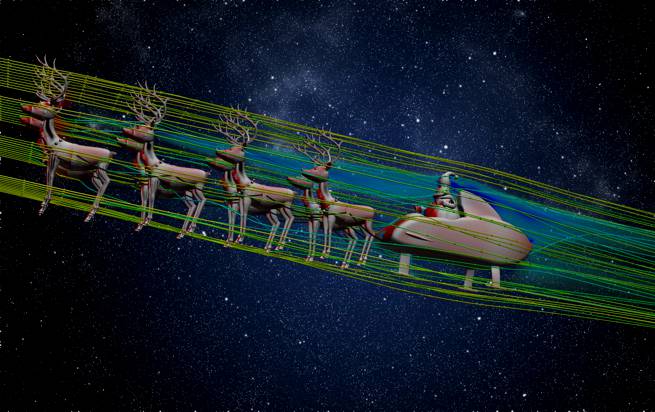
CFD can help Santa make his sleigh more aerodynamic for the holidays.
Latest News
December 22, 2016
By Chris Beves, Siemens PLM Software
There are few people that are busier traveling during the month of December than one Mr. S. Claus himself. When traveling such long distances it’s hard to survive on mince pies (or cookies), a glass of milk (or brandy) and a few carrots for the reindeer alone. So any chance of cutting down the time taken to deliver presents would no doubt be a welcome one. As Santa delivered his fair share of presents to me, I figured I’d give something back and help him out with something that has bothered me for a long time; the aerodynamics of his sleigh.
Whilst his sleigh has stood the test of time, save for a few coats of paint, a state of the art SAT-NAV system and maybe some weight reduced jingle bells, the aerodynamic performance is where he’s got the most to gain, or—in the case of aerodynamic drag—lose. This is where computational fluid dynamics (CFD) can help, particularly with STAR-CCM+, where we can analyze, design and test aerodynamic performance in the virtual realm without the need for Santa to physically be there for testing and diverting his attention away from who’s being naughty or nice.
So we’ll investigate the lift and drag of his “classic” sleigh with reindeer at a modest speed of 350 kph. This is not only because supersonic travel overland has been banned for many decades, but due to the high friction at such speed is how Rudolph’s nose really glows. The CFD results show that Santa and his reindeer have a lift coefficient “CL” of -0.06 (425 N of force downwards) and a drag coefficient “CD” of 1.32 (9,200 N of force opposite his direction of travel), which is close to 900 kW of power at 350 kph. It’s safe to say, if his reindeer weren’t bred specifically because of their thrust vectoring ability, Santa probably wouldn’t be able to get off the ground.
The CFD results of the classic sleigh show from the flow streamlines it’s clear where the drag reduction gains can be made, streamlining the overall sleigh effectively makes it bigger—so he can carry larger presents, or make fewer re-stocking stops along the way! The old railing system beneath the sleigh will also disturb the air, so replacing it with three low drag profile ski’s will help. Finally, in order to cover up the presents and help minimize the drag of Santa’s own portly aerodynamic profile a retractable fairing behind him is installed. These changes give a 30% drag reduction to CD=0.93. The addition of a small canard (or winglet) to the front of the sleigh has increased the lift so that now CL=0.01, so there is now he has a small amount of lift!
So now Santa has the option of a new, more aerodynamically efficient sleigh to make his yearly rounds. Unless of course he has perfected some sort of wormhole technology, in which case he’s traveling through a higher dimension and aerodynamic drag is the least of his concerns. Let’s just hope this isn’t the case, as dimensional vortexes would make a horrible tree decoration. But in the spirit of the season, giving the updated sleigh design to Santa by using STAR-CCM+ will help him deliver better presents, faster.
Subscribe to our FREE magazine, FREE email newsletters or both!
Latest News







